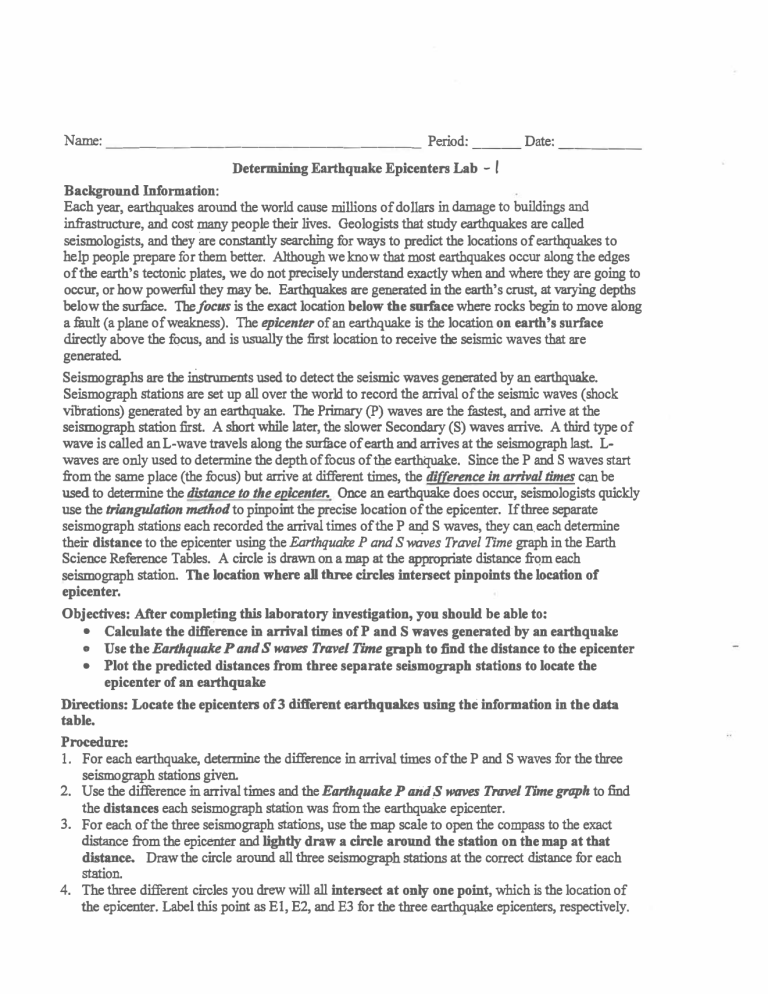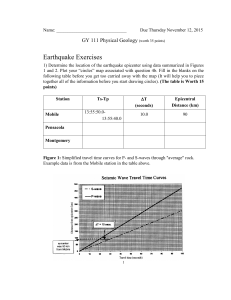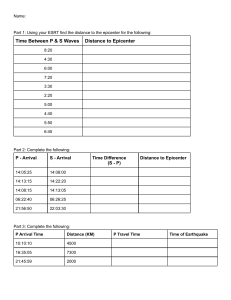
Name: ------------------- Period: --- Date: ----Determining Earthquake Epicenters Lab - f Background Information: Each year, earthquakes around the world cause millions of dollars in damage to buildings and infrastructure, and cost �y people their lives. Geologists that study earthquakes are called seismologists, and they are constantly searching for ways to predict the locations of earthquakes to help people prepare for them better. Ahhough we know that most earthquakes occur along the edges of the earth's tectonic plates, we do not precisely understand exactly when and where they are going to occur, or how powerful they may be. Earthquakes are generated in the earth's crust, at varying depths below the surface. Thefocus is the exact location below the smface where rocks begin to move along a fault (a plane of weakness). The epicenter ofan earthquake is the location on earth's surface directly above the fqcus, and is usually the first location to receive the seismic waves that are generated. Seismographs are the instruments used to detect the seismic waves generated by an earthquake. Seismograph stations are set up all over the world to record the arrival of the seismic waves (shock vibrations) generated by an earthquake. The Primary (P) waves are the fastest, and arrive at the seismograph station first. A short while later, the slower Secondary (S) waves arrive. A third type of wave is called an L-wave travels along the surface of earth and arrives at the seismograph last. L­ waves are only used to determine the depth of focus of� earthquake. Since the P and S waves start :from the same place (the focus) but arrive at different times, the difference in arrival times c� be used to determine the distance to the epicenter. Once an earthquake does occm, seismologists quickly use the triangulation method to pinpoint the precise location of the epicenter. If three separate seismograph stations each recorded the arrival times of the P an� S waves, they can. each determine their distance to the epicenter using the Earthquake P and S waves Travel Time graph in the Earth Science Reference Tables. A circle is drawn on a map at the appropriate distance frQm each seismograph station. The location where aD three circles intersect pinpoints the location of epicenter. Objectives: After completing this laboratory investigation, you should be able to: • Calculate the difference in arrival times of P and S waves generated· by an earthquake • Use the Earthquake P and S waves Travel Time graph to find the distance to the epicenter • Plot the predicted distances from three separate seismograph stations to locate the epicenter of an earthquake Directions: Locate the epicenters of 3 different earthquakes using the information in the data table. Procedure: 1. For each earthquake, determine the difference in arrival times of the P and S waves for the three seismograph stations given. 2. Use the difference in arrival times and the Earthquake P and� waves Travel Time graph to find the distances each seismograph station was from the earthquake epicenter. 3. For each of the three seismograph stations, use the map scale to open the compass to the exact distance from the epicenter and lightly draw a circle around the station on the map at that distance. Draw the circle around all three seismograph stations at the correct distance for each station. 4. The three different circles you drew will all intersect at only one point, which is the location of the epicenter. Label this point as E 1, E2, and E3 for the three. earthquake epicenters, respectively. SEISMIC WAVE DATA TABLE Earth.quake Epicenter Station ID A P-Wave Arrival Time 9:31:40 a.m S-Wave Arrival Time 9:35:50 am 1 B 9:21:00 a.m 9:24:30 am. C 9:35:00 a.m 9:40:50 a.m. D 2:06: lO p.m. 2: 12:50 p.m. E 2:13:40 p.m 2: 18:50 p.m. F 2:16:40 p.m 2:21 :20 p.m. G 6:52:20 a.m 7:01:00 a.m. H 6:50:00 a.m 6:58:50 a.m. I 6:48:00 a.m. 6:54:20 a.m 2 3 Time Difference (min:sec) Distance From Epicenter (Kl\1) Summary Questions: 1. For each earthquake, ide�ify which seismograph station had the smallest difference between the arrival times ofthe P and S waves: Earthquake #1: _______ Earthquake #2: _______ Earthquake #3: _______ 2. When the difference between the arrival times of the P and S waves is smaller, the distance to the epicenter of the earthquake is ___________ 3. For each earthquake, identify which seismograph station had the largest difference between the arrival times of the P and S waves: Earthquake #1: _______ Earthquake #2: _______ Earthquake #3: _______ 4. When the difference between.the arrival times of the P and S waves is larger, the distance to the epicenter of the earthquake is ___________ 5. Which earthquake epicenter was located in the United States? _______ 6. Which earthquake epicenter was·located in Canada? _______ 7. Which earthquake epicenter was located in Mexico? _______ 8. Why are three seismograph stations necessary to locate the epicenter of an earthquake? 9. The locations of earthquakes throughout the world tend to occur in narrow bands. Vlhat do the locations of earthquakes represent? ________ _____________ £t�LE fll II I Ill l}lll\lll lllllllll·� 111 Ill 11)1 ti} IHI llll\ll lll)ll\l JI ID 1\1 lllllll II II� 0 I 2 � 4 5 Kilo.tirs x l o3 ( I " 11 �00 xm) 6 7 S £x+ra .£c�LE f11111 m1p m111Hl\l1111�11111111)1 \ll 11111111111m1111111 m J\l n\I Ill 11 m1 0 I 2. 3 4 5 Kilo�s x \o1 ( 1,.1poo K ➔ 6 7 8 Map







